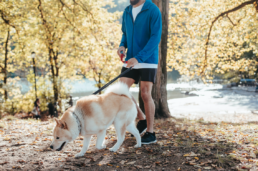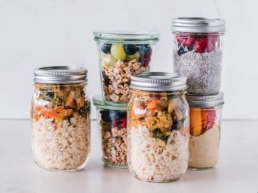By Barbara Martinez-Benavides, First Mile Care DPP Coach
Summer is here and with most pandemic restrictions lifted, people are excited about traveling farther afield for vacation. Despite higher costs, there’s probably a driving trip on your horizon this summer and possibly a flight. Traveling is one of the best ways to break out of your routine, recharge your batteries, and create new memories (and jigsaw puzzles!) to share with friends and family — even if the travel destination is only a couple of hours away.
If you’re trying to change your lifestyle to become healthier, traveling away from home for vacation or business poses risks. Successful lifestyle change involves identifying triggers for unhealthy behaviors and developing new eating and exercise habits. Changing your routine, while a great stress reliever, also means you may sabotage those new habits you’ve been working so diligently to establish. On the plus side, travel provides the opportunity to do different types of exercise and to discover new seasonal foods and healthy brands you might not otherwise know.
A little backsliding during vacation is normal. The important thing is that if you do gain weight during vacation, that you don’t become discouraged. Instead, update your action plan, reset your goals, and continue working towards them. The First Mile Care Diabetes Prevention Program doesn’t label foods or behaviors as “good” or “bad.” What’s key is that you learn to balance your food choices and get enough activity into your daily routine to address your caloric intake to stop or reverse prediabetes.
Whether you’re going on a road trip or hunkering down in your annual vacation cabin, how can you avoid succumbing to temptation and undermining your hard-won achievements?
Location, location, location
It’s easier to control the quantity and quality of your meals if you are fixing them yourself, just as you do at home — and a lot less expensive, too. If you have the option of staying in a motel or rental home with a kitchen, you can more closely approximate the healthy meals you have at home. You can also enjoy checking out what’s available in the local markets.
But not everyone enjoys meal planning. Or perhaps your idea of vacation is to have someone else do the cooking for you? I previously wrote on how to stay on track with your eating goals when dining in restaurants — tips such as deciphering the menu, making substitutions, and rightsizing your meal.
The “highway to the Danger Zone” of fast food can be found en route to your vacation destination. Airports, train stations, and roadside diners are often the exclusive preserve of fast food, whether familiar chains or Mom ‘n’ Pop stands. But don’t despair; there are healthier choices available depending upon the type of restaurant you choose, as I recently described in an article on fast-food dining.
Jeannie Lawson is a Houston-area resident who has completed the First Mile Care Diabetes Prevention Program. “I used to not pay attention to what I ate when I traveled, so I might lose weight but then gain it back while traveling. Now I’ve developed the habit of tracking calories as a result of the First Mile Care program and continue making healthy choices even when I’m eating away from home. For example, I spent a week at a spa hotel in Mexico which has fabulous food. I’ve gone to that hotel several times over the years and have always gained at least five pounds. But after being in the First Mile Care program, even though I didn’t actively track that week, it was always in the back of my mind. I knew the choices I was making and how to reconcile them. This time I only gained one pound — which I easily lost at home.”
Respect the zzzzzz
A change in sleeping habits often accompanies a change in venue. It could be attributed to a different time zone, a strange mattress, eating late, or drinking more alcohol than normal. You may be cramming as many wakeful hours of fun as possible into your limited vacation time. It could be all these things combined!
We all know how sleep affects mood, problem solving, and memory, among other mental impacts. But there is also a strong connection between inadequate sleep and weight gain. Sleep affects two hormones, leptin — which tells your body that you’re full — and ghrelin — which tells you when you’re hungry. A restful seven hours a night is considered the minimum amount of sleep for adults. Resist the temptation when traveling to burn the candle at both ends. Instead, try to maintain good sleep hygiene to reduce the possibility of hauling home extra vacation pounds among your souvenirs.
Keep moving
An important component of the Diabetes Prevention Program (DPP) is getting regular exercise. First Mile Care recommends setting a goal of at least 150 minutes per week of physical activity in a variety of types of exercise.
If you’re doing a driving trip, you’ll obviously be doing a lot of sitting. You’ll want to make regular 10- to 15-minute stops at least every couple of hours to do some stretches and give the driver’s eyes and muscles a break. When you’re the passenger, you can do calf raises or triceps pushes while you ride.
When you’re traveling away from home for business or pleasure, you might not have access to a gym. Even if you do, spending part of your precious vacation time trapped in a tiny hotel gym is not especially appealing. Probably the easiest way to make sure you get an adequate amount of exercise while on vacation is to walk everywhere you can. It’s a great way to explore a new place or to reacquaint yourself with a place you may already know. You’ll notice more of your surroundings and may discover new shops or sights that are easily missed from a car window. You can also march in place, dance, do wall push-ups, and climb stairs instead of sitting all day.
One way to fit workouts into your travels is to bring a few packable items of exercise equipment. A flat resistance band weighs little and will fold up. A small exercise ball, when deflated, can be packed into a suitcase. If staying with friends, you can always borrow some canned food or water jugs to use as DIY weights. There are also live or on-demand streaming workouts of varying lengths that don’t require equipment that you can do through a fitness app.
And, of course, many people plan vacations specifically around physical activity despite the summer heat, taking camping, biking, and hiking trips, staying by lakes or rivers for water sports like swimming, paddling, rowing, and waterskiing, or visiting aquatic parks, amusement parks, and resorts that involve outdoor activities. And if you are staying in a resort, there could be walking tours or fun fitness classes (beach volleyball, diving, surfing, or tennis) either offered by the hotel or at a nearby facility.
Mike Kowis is a Houston-area “graduate” of the First Mile Care Diabetes Prevention Program. “Once I started the First Mile Care program, I became more mindful of my activity level. My daily steps have become such a habit that even when I was traveling out of town and checked into a hotel late at night, I went outside for a walk just before midnight to make sure I hit my daily goal. Although I tracked my calorie intake for about six months, when my wife and I took a vacation trip to Montana during the summer, I stopped tracking. I did get in a ton of walking so didn’t see any ill effects. I have found that my weight only fluctuates up or down by a couple of pounds because I am keeping up my activity level and eating the same foods. And the MyFitnessPal app for food tracking is there on my phone should I ever need it.”
Guilt-free fun
With simple tweaks, you can get in your minimum activity without feeling that you’re missing out on fun with family and friends. Walking instead of riding, swimming instead of floating, taking the stairs instead of the elevator — any movement is good movement and will help offset your well-deserved vacation meal indulgences.
Says Olidia Thomas, a Michigan resident who is currently participating in the First Mile Care program, “When I went on a vacation with friends recently, I packed healthy snacks, cooked in the resort kitchenette, and was more conscious of staying active and eating balanced meals. I found that keeping a food journal is helpful. I still eat the things I love in moderation. I just keep track of the calories and try to stay within the guidelines. Most importantly, I forgive myself when I go off course. Knowing I can fall off the wagon and get back on is important. It’s not the end of the program.”
To learn more about how you can benefit from the First Mile Care Diabetes Prevention Program, take the prediabetes risk test and get started today!



